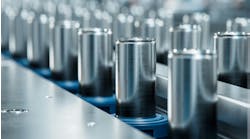Manufacturers of battery chemicals face a significant hurdle: They must scale their processes to meet increasing demand for lithium-ion batteries (LIB) while reducing their carbon footprints. Chemical companies like BASF are meeting this challenge by recycling LIBs and recovering the cathode active material (lithium, nickel, cobalt and manganese), anode active material (graphite, silicon and lithium) and residual metals (copper and aluminum) known collectively as “black mass” for reuse.
The recycling process involves LIB discharging, mechanical shredding, drying and recondensation of electrolytes as well as sorting and classification. Each step has several alternative approaches depending upon the type of battery, its size or shape and the quantities. We’ll cover drying in my next column. For now, let’s focus on the initial steps of discharging and mechanical shredding.
First Step: Discharging Used Batteries
To ensure safety, it is essential to completely discharge the batteries to a fully depleted state of charge (SOC). This precaution is necessary because even after use, batteries retain stored energy, which, in the presence of a spark, can lead to a fire generating extremely high levels of heat that can be challenging to control.
Alternatives for this initial step include thermal pretreatment, saltwater brine baths and controlled discharge via external circuits. While each technique has benefits, the consensus in the market is that saltwater brine-based discharge is preferable for small-format or consumer batteries and controlled discharge is preferred for electric vehicle (EV) batteries. With both of these approaches, the time required for battery discharge depends upon several factors, including battery quality and type and quality of the brine solution in the case of consumer batteries. Currently, researchers are studying many types of brine solutions and concentrations. The actual brine type used is normally determined during process commissioning and startup.
Mechanical Shredding: A Multi-faceted Step
Mechanical shredding-crushing-granulating of the LIBs can be a single or dual-stage process depending on the battery application, which can vary from electric vehicles to consumer power tools. A single-stage process involves only the pre-shredder stage. This typically uses a low-speed, high-torque rotary shear shredder designed to shred and liberate materials within the machine until they are small enough to pass through a removable screen below the cutters. The rotary shears are available in dual-shaft to quad-shaft designs.
In dual-stage processes, the second stage involves a high-speed and low-torque granulating or cutting machine. A granulator is composed of a rotor with attached blades that cuts the LIBs to certain sizes capable of passing through the integrated screen. The cutting component consists of high cutting surface area and unique cutting geometry (an array of knives positioned both lower and higher overlap continually when cutting). This breaks down the incoming material uniformly and with clean cuts. The granulators are also designed with pusher systems to ensure a consistent material feed and pressure.
Three Types of Mechanical Operations
For both single- or dual-stage operations, there are three main approaches to consider:
- In wet shredding, manufacturers use either a pre-shredder and/or granulator submerged in a brine/water solution. This has the benefit of combining the discharging and shredding in one step. However, large quantities of brine are needed, which may result in increased wastewater treatment.
- In dry shredding, operators use a nitrogen or carbon dioxide environment to eliminate safety issues. The use of an inert gas flow to creates a gas blanket, which displaces the oxygen to eliminate any fire hazards.
- Finally, a cryogenic liquid nitrogen environment, at -196 degrees C, can be employed to prevent violent reactions followed by a hammer mill to crush the material.
There is no one way to begin discharge and mechanical destruction in the battery recycling process. Each approach has advantages and drawbacks as well as opportunities for improvement as more plants come online. When determining the best choice, it's important to consider both operator and environmental safety while completing the circular economy loop.



